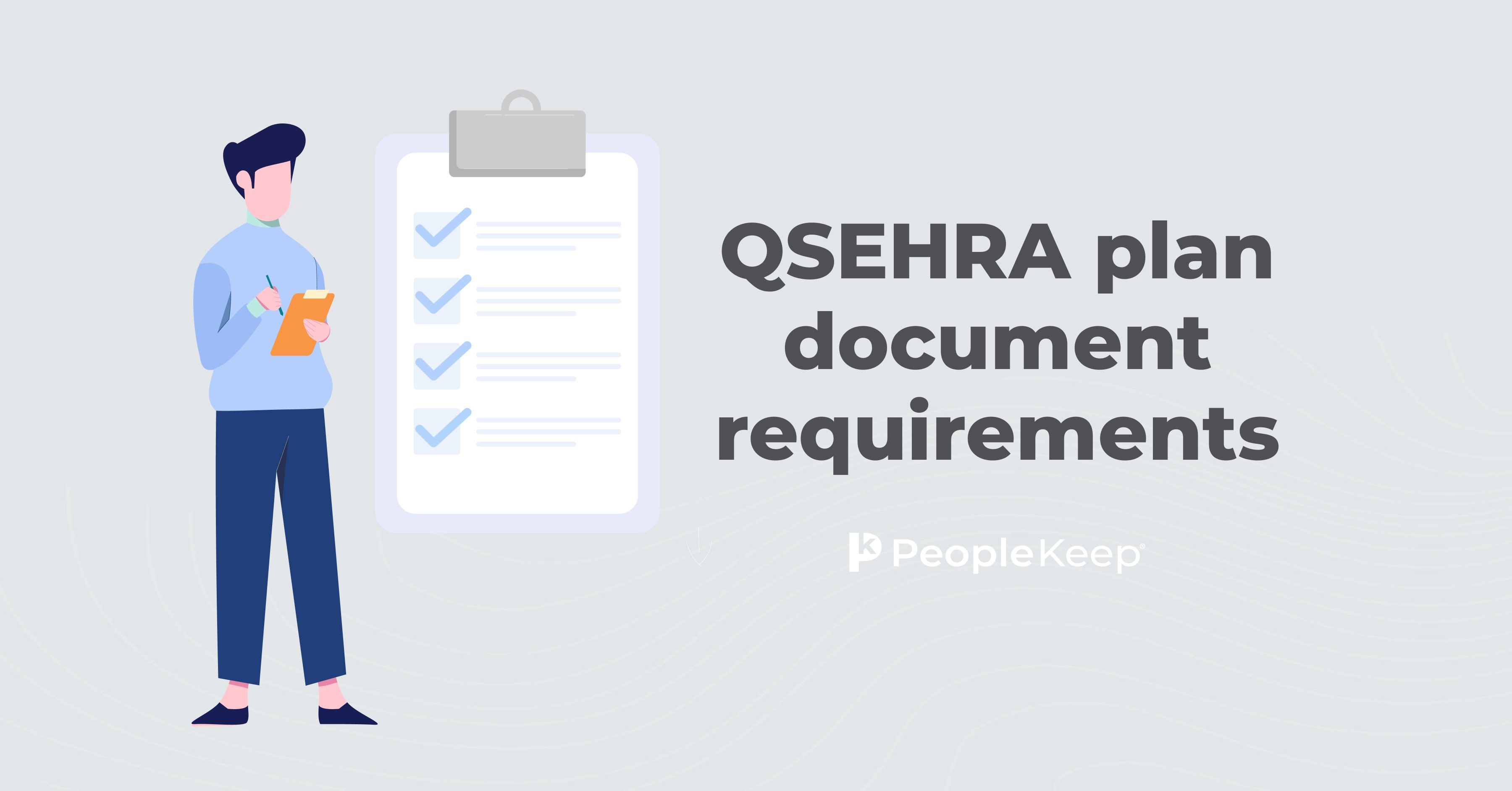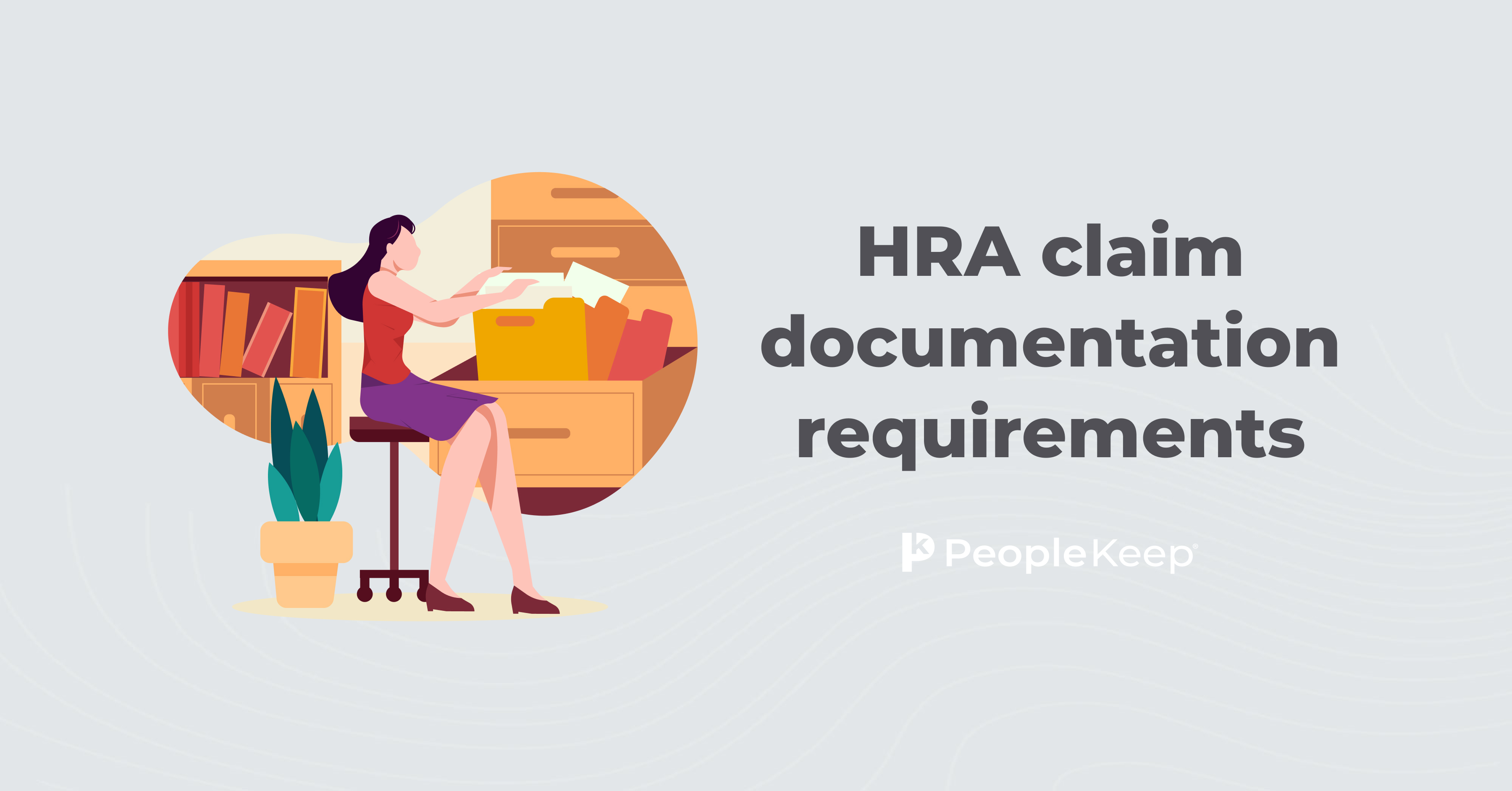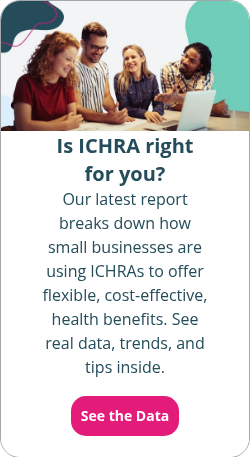What are the ICHRA plan document requirements?
By Holly Bengfort on April 4, 2024 at 6:30 AM
The individual coverage health reimbursement arrangement (ICHRA) allows employers to provide a health benefit in which they can reimburse their employees, tax-free, for an individual health insurance plan's monthly premiums and other qualifying out-of-pocket costs. It allows employers to design a flexible health benefit that fits their employees' needs.
Understanding ICHRA requirements is vital to keeping your benefit plan compliant. One of the first steps in setting up an ICHRA is to create formal plan documents that the Employee Retirement Income Security Act (ERISA) and the IRS require.
In this article, we'll go over why your organization needs ICHRA plan documents, what they must include, and the options you have to create them, including using an HRA administration software solution like PeopleKeep.
Takeaways from this blog post:
- To comply with federal regulations, employers must have a written plan document and summary plan description (SPD) in place for their ICHRA.
- ICHRA plan documents should include information like named fiduciaries and plan administrators, eligibility requirements for participants, and effective dates of participation.
- The plan documents should also include information on plan benefits, funding for the ICHRA, payment methods, and claims procedures.
What is an individual coverage HRA (ICHRA)?
The ICHRA is a cost-effective, customizable alternative to a one-size-fits-all group health plan. With it, employers of all sizes can reimburse their employees for medical care expenses, such as individual health insurance premiums and more than 200 other out-of-pocket costs outlined in IRS Publication 502 and the CARES Act.
Some HRA-eligible expenses include:
- Doctor visits
- Prescriptions
- Over-the-counter medication
- Mental health counseling
- Birth control
Because reimbursements to employees are tax-free, organizations leveraging an ICHRA will receive similar tax benefits to those employees enrolled in traditional group health plans receive.
Setting up an ICHRA is easy. The employer sets a fixed monthly allowance for each employee. After attestation of individual health plan coverage, employees spend that money on eligible healthcare expenses and submit proof of the expense to their benefit administrator.
After the employer or benefit administrator reviews the documentation and approves the reimbursement, the employer reimburses the employee up to their allowance amount.
There are no caps on how much money the employer can offer through their ICHRA, and they also have certain flexibility on eligibility. For example, employers can decide eligibility for coverage based on employee classes and set different allowances for employees in different class structures.
Even better, employers can offer an ICHRA as a stand-alone health benefit or alongside group health insurance. However, employers can't offer an employee class a choice between a group health insurance plan and an ICHRA—they can only offer one of the benefits to each class.
Why your organization needs ICHRA plan documents
ICHRAs are subject to ERISA regulations because the federal government classifies them as group health plans. ERISA Section 402 states that every employee benefit plan must be “established and maintained pursuant to a written instrument” or plan document. ERISA also requires the organization to make the document available to employees and their families.
Plan sponsors, typically the employer, must also create a summary plan description (SPD), also called a summary plan document, which summarizes the whole document to participants. While the plan document is written in a legal manner, the SPD must be in plain language that the average plan participant can easily understand.
To assist with drafting documents, ERISA § 2520.102-31 outlines what the SPD should include, including participants' benefits, rights, and obligations under the plan.
There are no specific penalties for failing to meet these requirements. Still, an employer will be subject to IRS fines if ICHRA participants ask to see the plan document and the employer doesn't produce it.
Additionally, the employer could receive more fines if it doesn't deliver the SPD to participants within 120 days of the ICHRA's creation. For new participants in an existing ICHRA, employers have 90 days to provide the SPD.
10 items your ICHRA plan documents must include
ERISA outlines several items every legal plan document must include. However, there are additional items relating to the ICHRA that businesses should also include as a best practice.
Below, we explain in detail the ten items your ICHRA plan documents should include and if they're an ERISA requirement. You can use these points to create an ICHRA plan document template.
1. Named fiduciaries and plan administrators and their responsibilities
The ICHRA plan documents must name one or more fiduciaries. These named fiduciaries have the authority to control and manage how the ICHRA is administered.
By naming these individuals in the plan documents, they agree to accept fiduciary duty for ICHRA participants. This means they'll act solely in the best interest of plan participants and pay only reasonable medical expenses.
The plan document should also name a plan administrator for the ICHRA and specify the administrator's powers.
Potential plan administrator powers include:
- Interpreting the plan
- Designing ICHRA participant forms
- Communicating the ICHRA to participants
- Signing plan administration documents
- Maintaining relevant plan data
- Appointing people to assist in plan administration services
Generally, you name the company as the fiduciary and plan administrator.
2. Eligibility requirements for the ICHRA
The plan document must clearly outline the eligibility criteria for employees to participate in the ICHRA.
Under the Departments of the Treasury, Labor, and Health and Human Services proposal, all participants must have individual health insurance coverage to participate in the ICHRA. Only W-2 employees can participate. Beyond that, the employer can structure eligibility according to the 11 employee classes.
The spouses and dependents of eligible employees can also participate in the ICHRA if they have qualifying individual health insurance coverage.
Offering an ICHRA triggers a special enrollment period for employees. This special enrollment period gives them a 60-day window to obtain quality healthcare through the Health Insurance Marketplace outside of the regular open enrollment period. This gives your employees plenty of time to enroll in a qualifying individual health insurance plan.
3. Effective dates of participation (start dates)
The plan document should define the effective dates of participation for employees eligible for the ICHRA. These dates specify when eligible employees can participate in the benefit, such as whether the business imposes a waiting period on employees.
Employers can choose an effective date as early as the employee's start date or as late as 90 days after their date of hire.
4. Description of plan benefits
The plan document should include which out-of-pocket expenses are and aren't eligible for reimbursement through the ICHRA.
According to guidelines, the ICHRA can reimburse eligible expenses listed in IRS Section 213(d) as “medical care.” The employer can make exclusions but should provide an itemized list in the plan document to clarify those exclusions.
In this section of the legal document, employers should also specify monthly reimbursement amounts available to employees according to any of the 11 employee classes the employer sets.
5. How the ICHRA is funded and how it makes payments
The plan document must specify how the company makes payments to and from the ICHRA.
This payment process largely depends on how the organization administers the benefit plan. There's no requirement that an employer must pre-fund an ICHRA, but some third-party administrators (TPAs) may require this.
Generally, funds don't leave the organization until the employer or TPA verifies and approves the employee's expense for reimbursement.
6. ICHRA claims procedures
The plan document must create and follow reasonable procedures relating to the claims process. With an ICHRA, a “claim” is a reimbursement request from a participant.
To comply with ERISA requirements, ICHRA plan documents must create procedures governing:
- How employees file claims for reimbursement
- How the administrator will notify participants of claim processes and decisions
- How the business will handle appeals of denied claims
Business owners have some freedom in crafting these procedures, but ERISA offers some specific guidelines.
Additionally, the IRS requires employees to substantiate their claims. This includes submitting a receipt or invoice that includes the name of the service or product, the date of the service, and the amount the employee incurred.
If you reject an employee’s reimbursement claim, you must notify them within 30 days of receiving their request. If you rejected the claim because the employee needs to submit more information, they have 45 days to do so.
7. HIPAA privacy officers and rules regarding protected health information (PHI)
If your organization has fewer than 50 full-time employees, the federal government doesn’t require it to comply with most HIPAA rules.
However, it's still subject to the HIPAA Privacy Rules. These rules control the conditions under which the ICHRA can share protected health information (PHI) with the company.
To comply with these requirements, the plan document should designate HIPAA privacy officers. This group, or individuals, will be exposed to participants' PHI and are almost always the plan administrator.
The plan documents should also outline rules regulating the use and disclosure of PHI according to HIPAA Privacy Rules. Finally, it should address PHI protection, per HIPAA Security Rules2.
If a business with 50 or more employees offers an ICHRA, it needs to address all other sections of HIPAA as well.
8. Information on federal mandates
The plan document must address how the ICHRA behaves concerning certain federal mandates, including the Family and Medical Leave Act (FMLA) and Uniformed Services Employment and Reemployment Rights Act (USERRA). How the ICHRA responds to these mandates largely depends on the organization's size.
9. The procedure for amending the plan
The plan document must outline steps the organization will take if it decides to amend the plan. These steps include naming individuals who have the authority to amend the plan and the process the business will take in notifying employees of a “material amendment” to the plan.
ERISA requires that businesses notify participants no later than 210 days after the close of the plan year during which the amendment was made. However, if the amendment “materially reduces” the ICHRA's benefits or services, the business must notify participants within 60 days.
10. The procedure for plan termination
The plan document should detail the business's and participants' rights if the company decides to terminate the ICHRA.
Options for creating ICHRA plan documents
Creating ICHRA plan documents isn't a task employers should take lightly. These documents must follow all ERISA and IRS requirements exactly, making it easy for novices to be noncompliant. If an employee or government agency challenges the documents, the business may face daily penalties of $100 per employee until they're corrected.
Many small businesses contract with an attorney to draft the plan documents and SPDs to avoid this problem. However, the estimated cost for this convenience can often exceed $2,000. Even prewritten plan documents could cost at least $200.
Additionally, neither of these services provides free plan amendment procedures. The best option to avoid these difficulties is working with an HRA administration platform like PeopleKeep.
PeopleKeep provides customers with personalized plan documents as well as free and immediate plan amendments. We help employers administer their HRA online, document reimbursements, and leverage tools to ensure employers remain compliant with federal and state rules so they can maintain control of their time and money.
Conclusion
Adding an individual coverage HRA (ICHRA) to your benefits packages is a great perk. But meeting plan document requirements can be a difficult task. There are several complicated regulations, and if you're out of compliance, you could face penalties until you correct the errors.
If keeping up with changing regulations sounds overwhelming, use a benefits administration software like PeopleKeep! We take care of the time-consuming tasks of managing your ICHRA, so you don't have to. If you're ready to get started, schedule a call, and we'll take it from there.
This article is for informational purposes only. To ensure compliance with the law, you should seek advice from legal or tax professionals.
This article was originally published on May 7, 2019. It was last updated on April 4, 2024.
Check out more resources
See these related articles

QSEHRA plan document requirements
In this post, we’ll discuss the requirements associated with QSEHRA plan documents and what information those documents should include.

Section 105 Plan Document Requirements
Section 105 Plan Document Requirements. What the Section 105 Plan Documents are required to include, and why you need plan documents for Section 105 Plans.

HRA claim documentation requirements
In this article, we’ll go over the five HRA claim documentation requirements and how PeopleKeep makes the review process quick and easy for employers.



